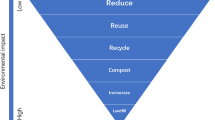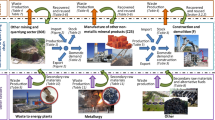Abstract
The transition from linear economy to circular economy (CE), which can reduce natural resource depletion and minimize waste generation, has become a worldwide trend. The current challenge for Vietnam is to identify the key areas for the transition, given that financial resources are limited and that a detailed and comprehensive accounting of waste generation and collection for decision-making is lacking. This study aims at filling the gap by analyzing the waste flows throughout the supply chains and identifying the key areas for the CE transition in Vietnam. The 2018 updated IO table is used as an econometric tool to identify direct and indirect waste collection intensity for all types of waste. The result shows that in terms of waste intensity, among primary sectors, Coke and the group of Mining and Extraction industries (S4-S7) have significant room for reducing waste. In terms of IO interaction, collection rate and recyclable potential of waste, among secondary sectors, Paper production and services (S11), Plastics (S16), and Building materials (S17) should be prioritized for the CE transition in Vietnam. Having a long supply chain and meeting all priority criteria, Plastics is identified as one of the key industries to be selected to exemplify managerial implications to show which solutions/innovations should be proposed in each circular economy period to improve sustainable efficiency.





Similar content being viewed by others
Data availability
The data that support the findings of this study are available from the corresponding author upon reasonable request.
Code availability
Not applicable.
References
Beylot, A., Boitier, B., Lancesseur, N., & Villeneuve, J. (2016). A consumption approach to wastes from economic activities. Waste Management, 49, 505–515. https://doi.org/10.1016/j.wasman.2016.01.023
European commission (EC) (2015). Communication from the commission to the parliament, the council and the European economic and social commitee and the commitee of the regions: Closing the loop–An EU action plan for the Circular Economy. COM/2015/614 final. Brussels: European Commission. Retrieved 12 Sep 2021, from https://eur-lex.europa.eu/legal-content/EN/TXT/?uri=CELEX:52015DC0614
European commission (EC) (2019). Circular Economy: Commission welcomes European Parliament adoption of new rules on single–use plastics to reduce marine litter. Retrieved 19 Oct 2021, https://ec.europa.eu/commission/presscorner/detail/en/STATEMENT_19_1873
Curran, M. A. (Ed.). (2012). Life cycle assessment handbook: A guide for environmentally sustainable products. John Wiley & Sons.
Do Minh, K., & Nguyen, H. N. (2022). Measuring the circular economy for companies: A case study of a packaging company in Vietnam. VNU Journal of Economics and Business, 2(3), 100–110. https://doi.org/10.25073/2588-1108/vnueab.4645
Government of the Netherlands (2018). A circular economy in the Netherlands by 2050: A summary of the commitment and priorities of the government of the Netherlands. The Hague. Retrieved 2 Jul 2021, from https://hollandcircularhotspot.nl/wp-content/uploads/2018/09/Publicatie_CE_Engels.pdf
Hai, H. T., Quang, N. D., Thang, N. T., Nam, N. H. (2020). Circular Economy in Vietnam. In Ghosh S. (eds) Circular Economy: Global Perspective, Springer, Singapore https://doi.org/10.1007/978-981-15-1052-6_22
Hendrickson, C., Lave, L. B., & Matthews, H. S. (2006). Environmental life cycle assessment of goods and services: An input-output approach. Resources for the Future, Washington. https://doi.org/10.4324/9781936331383
Heshmati, A. (2017). A review of the circular economy and its implementation. International Journal of Green Economics., 11(3–4), 251–288.
Innovation for Sustainable Development Network (2018). Can public procurement in cities support circular economy and sustainability transition? Policy outlook series, the Hague. Retrieved 6 Oct 2021, from https://www.inno4sd.net/uploads/originals/1/inno4sd-outlook-6-2018.pdf/
Kalmykova, Y., Sadagopan, M., & Rosado, L. (2018). Circular economy–From review of theories and practices to development of implementation tools. Resources, Conservation and Recycling, 135, 190–201. https://doi.org/10.1016/j.resconrec.2017.10.034
Kurz, H. D. (2006). Goods and bads: Sundry observations on joint production, waste disposal, and renewable and exhaustible resources. Progress in Industrial Ecology, an International Journal, 3(4), 280–301. https://doi.org/10.1504/PIE.2006.011738
Lenzen, M., & Reynolds, C. J. (2014). A supply-use approach to waste input-output analysis. Journal of Industrial Ecology, 18(2), 212–226. https://doi.org/10.1111/jiec.12105
Liang, S., & Zhang, T. (2012). Comparing urban solid waste recycling from the viewpoint of urban metabolism based on physical input–output model: A case of Suzhou in China. Waste Management, 32(1), 220–225. https://doi.org/10.1016/j.wasman.2011.08.018
Liao, M. I., Chen, P. C., Ma, H. W., & Nakamura, S. (2015). Identification of the driving force of waste generation using a high-resolution waste input–output table. Journal of Cleaner Prodution, 94, 294–303. https://doi.org/10.1016/j.jclepro.2015.02.002
Marc, R., Xiong, Yu., & Zhou, Yu. (2019). Managing a closed-loop supply chain with process innovation for remanufacturing. European Journal of Operational Research, 276(2), 510–518.
Ministry of the Environment and Water Resources (MEWR) (2019). Zero Waste Masterplan.
Miller, R.E., Blair, P.D. (2009). Input-output analysis: foundations and extensions (2nd ed.). Cambridge University Press.
Ministry of Natural Resources and Environment (MONRE) (2018). Report on the current state of the environment in 2017 (in Vietnamese).
Mol, M. J., & Julian, B. (2009). The sources of management innovation: When firms introduce new management practices. Journal of Business Research, 62(12), 1269–1280.
Mongelli, I., Suh, S., & Huppes, G. A. (2005). Structure Comparison of two approaches to LCA inventory data, based on the MIET and ETH databases (10 pp). The International Journal of Life Cycle Assessment, 10(5), 317–324.
Nakamura, S., & Kondo, Y. (2002). Input-output analysis of waste management. Journal of Industrial Ecology, 6(1), 39–63. https://doi.org/10.1162/108819802320971632
Nakamura, S., Nakajima, K., & Kondo, Y. (2007). The waste input-output approach to materials flow analysis. Journal of Industrial Ecology, 11(4), 50–63. https://doi.org/10.1162/jiec.2007.1290
Nam, N. H., & Hanh, N. T. (2019). Implementing circular economy: International experiences and policy implications for Vietnam. VNU Journal of Science: Economics and Business, 35(1), 68–81. https://doi.org/10.25073/2588-1108/vnueab.4277
Nguyen, T. A. T., & Ishihara, N. K. (2006). Analysis of changing hidden energy flow in Vietnam. Energ Policy, 34(14), 1883–1888. https://doi.org/10.1016/j.enpol.2005.01.011
Nguyen, D. Q., Ha, V. H., Eiji, Y., & Huynh, T. H. (2017). Material flows from electronic waste: Understanding the shortages for extended producer responsibility implementation in Vietnam. Procedia CIRP, 61, 651–656. https://doi.org/10.1016/j.procir.2016.11.184
Nguyen, T.A.T et al. (2020). Working paper of B2017-BKA-42 project on buiding a waste 399 input-output table for Vietnam (in Vietnamese). Ministry of Education and Training, Vietnam.
OECD, (2015). Extended producer responsibility. From http://www.oecd.org/env/waste/extendedproducerresponsibility.htm.
Ooms, J., Nam, N. H., Luong, N. D. (2020). Analytical report: Case studies and Best Practices for applying circular economy principles to the Vietnamese context. UNDP Vietnam.
Parfitt, J., Barthel, M., & Macnaughton, S. (2010). Food waste within food supply chains: Quantification and potential for change to 2050. Philosophical Transactions of the Royal Society B, 365(1554), 3065–3081. https://doi.org/10.1098/rstb.2010.0126
Picuno, C., Alassali, A., Chong, Z. K., & Kuchta, K. (2021). Flows of post-consumer plastic packaging in Germany: An MFA-aided case study. Resources, Conservation and Recycling, 169, 105515. https://doi.org/10.1016/j.resconrec.2021.105515
Pires, A., Martinho, G., Rodrigues, S., Gomes, M. I. (2019). Sustainable solid waste collection and management. Springer International Publishing.
Ruiz-Peñalver, S. M., Rodríguez, M., & Camacho, J. A. (2019). A waste generation input output analysis: The case of Spain. Journal of Cleaner Production, 210, 1475–1482. https://doi.org/10.1016/j.jclepro.2018.11.145
Salemdeeb, R., Al-Tabbaa, A., & Reynolds, C. (2016). The UK waste input–output table: Linking waste generation to the UK economy. Waste Management Research, 34(10), 1089–1094. https://doi.org/10.1177/0734242X16658545
Scottish Government (2016). Making things last: A Circular Economy Strategy for Scotland. Edinburgh, Scotland.
Soumyadeb, C., Prasanta, K. D., Oscar, R. E., Geoff, P., Nguyen, T. A. T., Dang, D. L., & Tran, P. H. (2022). Impact of organisational factors on the circular economy practices and sustainable performance of small and medium-sized enterprises in Vietnam. Journal of Business Research, 147(2022), 362–378. https://doi.org/10.1016/j.jbusres.2022.03.077
Tsukui, M., Kagawa, S., & Kondo, Y. (2015). Measuring the waste footprint of cities in Japan: An interregional waste input–output analysis. Journal of Economic Structures, 4(1), 1–24. https://doi.org/10.1186/s40008-015-0027-2
Tuyet, N. T. A., Yen, T. T., & Prasanta, K. D. (2022a). Developing a plastic cycle toward circular economy practice. Green Processing and Synthesis, 11(2022), 526–535. https://doi.org/10.1515/gps-2022-0014
Tuyet, N. T. A., Chi, T. T., Thuy, L. B., & Thanh, T. N. N. (2022b). Developing a provincial environmental performance index for the environmental health of Vietnam Environment. Advance online publication. https://doi.org/10.1007/s10668-021-02072-x
Vergragt, P., Akenji, L., & Dewick, P. (2014). Sustainable production, consumption, and livelihoods: Global and regional research perspectives. Journal of Cleaner Production, 63, 1–12. https://doi.org/10.1016/j.jclepro.2013.09.028
WEEE Forum (2012). The challenge of transposing WEEE II into national law. Retrieved October 28, 2021, from http://www.weeeforum.org/news/the-challenge-of-transposing-weeeii-into-national-law/
World Economic Forum (2014). Towards the circular economy: Accelerating the scale-up across global supply chains. Geneva, Switzerland. https://www3.weforum.org/docs/WEF_ENV_TowardsCircularEconomy_Report_2014.pdf Accessed on 07 Feb 2019
Zoé, K., Romain, G., & Olga, B. (2021). Exploring the opportunities in establishing a closed-loop supply chain under uncertainty. International Journal of Production Research, 59(5), 1606–1625.
Acknowledgements
This study is granted by the Ministry of Education and Training [research project number B2022-BKA-21], Vietnam.
Funding
This study is granted by the Ministry of Education and Training (Vietnam) for the research project B2022-BKA-21.
Author information
Authors and Affiliations
Contributions
TTAN is responsible for project management, IO analysis, case study, and manuscript preparation. YTT is responsible for all data processing and manuscript preparation. NHN is responsible for modelling literature review. All the authors have read and contributed to the manuscript.
Corresponding author
Ethics declarations
Conflicts of interest
Not applicable.
Ethics approval
Not applicable.
Consent to participate
Not applicable.
Consent for publication
Not applicable.
Additional information
Publisher's Note
Springer Nature remains neutral with regard to jurisdictional claims in published maps and institutional affiliations.
Rights and permissions
Springer Nature or its licensor (e.g. a society or other partner) holds exclusive rights to this article under a publishing agreement with the author(s) or other rightsholder(s); author self-archiving of the accepted manuscript version of this article is solely governed by the terms of such publishing agreement and applicable law.
About this article
Cite this article
Ta, Y.T., Nguyen, T.T.A. & Nguyen, N.H. Identifying key areas for circular economy: a waste collection input–output analysis in Vietnam. Environ Dev Sustain (2023). https://doi.org/10.1007/s10668-023-03741-9
Received:
Accepted:
Published:
DOI: https://doi.org/10.1007/s10668-023-03741-9




